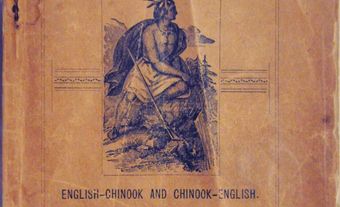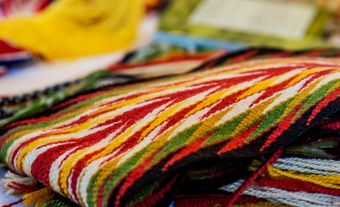Anishinaabemowin (also called Ojibwemowin, the Ojibwe/Ojibwa language, or Chippewa) is an Indigenous language, generally spanning from Manitoba to Québec, with a strong concentration around the Great Lakes. Elders share that the term Anishinaabemowin acknowledges the creation story of the Ojibwe people: “Anishinaabe” means “the spirit that is lowered down from above,” “-mo” refers to expression through speech and “-win” refers to the life energy within, used to do so. Linguists also explain that “-win” is a nominalizer that turns the verb Anishinaabemo (“he/she is speaking the Anishinaabe language”) into a noun. According to the 2021 Census, 25,440 people are listed as speaking Ojibwe languages.

Terminology: Anishinaabe and Ojibwe
Though many may use the terms Anishinaabe and Ojibwe interchangeably, they can have different meanings. Anishinaabe can describe various Indigenous peoples in North America. It can also mean the language group shared by the Ojibwe, Odawa, and Potawatomi peoples. Ojibwe, on the other hand, refers to a specific Anishinaabe nation. Anishinaabeg is the plural form of Anishinaabe and consequently, refers to many Anishinaabe people.
Anishinaabemowin, the term often used to describe the language of the Ojibwe specifically, can also be used to describe a language spoken by other Indigenous peoples of North America. Ojibwemowin, sometimes used interchangeably with Anishinaabemowin, refers specifically to the language spoken by the Ojibwe people.
Algonquian Linguistic Family
Anishinaabemowin is part of the Central Algonquian language family, which is a group of closely-related Indigenous languages (such as Odawa, Potawatomi, Cree, Menominee, Sauk, Fox and Shawnee) with similar sounds, words and features.
The Central Algonquian language is part of the larger Algonquian language family, which spans from the Rocky Mountains (Blackfoot Confederacy territory) to the Eastern Seaboard (where Mi’kmaq is spoken).
Writing the Language
Anishinaabemowin began as an orally transmitted language.
Historically, there was a specialized form of symbol writing to communicate teachings sacred to the Ojibwe people. While Anishinaabeg continue to honour symbol writing, written forms of Anishinaabemowin using Roman orthography (i.e., the Latin alphabet, such as that used by the English language) is the primary form of written communication.
Christian priests and missionaries who traveled to Ojibwe territories were the first to write Anishinaabemowin using the Latin alphabet. (See also Indigenous Territory.) Slovenian Roman Catholic missionary Frederic Baraga actively learned Anishinaabemowin as a means of promoting the conversion of Indigenous people to Christianity. As a tool for fellow missionaries, Baraga authored the Dictionary of the Otchipwe Language in 1853. Otchipwe (a misnomer of Ojibwe) is a basis for the term Chippewa. The writing systems employed by missionaries can best be described as folk-phonetic style.

In 1840, Methodist clergyman and missionary James Evans created a system of syllabics following his travels among the Cree of Norway House. Using a system of glyph-symbols that represented combinations of consonants, vowels and final sounds, Evan’s system of syllabics spread widely among the Cree and Ojibwe peoples. Syllabics continue to be used in various capacities today.
Beginning in the mid-20th century, linguist Charles Fiero helped to develop the double-vowel system that is widely used today. Fiero’s system is considered easier to use than the folk-phonetic style, in which the spelling of words differs from person to person. An example of the difference between folk-phonetic style and Fiero’s system is as follows:
Action conveyed: “He/She is dreaming.”
Folk-phonetic style: Buh-waa-jih-gay.
Fiero’s system: Bawaajige.
Using Fiero’s double-vowel system, some vowel sounds may be long (aa, e, ii, oo) and some may be short (a, i, o), and the delivery of each sound can greatly alter the meaning. For example, zaaga’igan means “lake,” whereas the similarly-spelled zaga’igan means “nail.”
Speaking the Language
Traditional knowledge holders share that the language was originally created by Nanaboozhoo (sometimes spelled Nanabozo, also called Wenaboozhoo and Nanabush) after Gizhe Manidoo gave him life, lowered him to the Earth, and gave him the responsibility to name everything in existence. By means of Nanaboozhoo’s task, Anishinaabemowin was born and spoken into existence.
Elders often speak about the importance of Anishinaabemowin to Anishinaabe culture and society. In addition to routine communication, the language is essential in the officiating of Ojibwe ceremonies and the repatriation of sacred items as well as in providing a unique way of understanding the world. The survival of Anishinaabemowin is directly related to the survival of Anishinaabe identity and culture.
Cultural protocols and understandings are built into Anishinaabemowin communication. For instance, the word boozhoo (“hello”) not only acknowledges the original spirit of Nanaboozhoo and guides relationships based upon respect, but conveys the process of using the breath of life (“boo”) to express the feeling of life (“zhoo”). The word for old woman (mindimooyenh) describes one who holds everything together from the family to the nation. Bawaajige (“he/she is dreaming”) communicates travelling in the form of spiritual light when the body is at rest. Aaniin, which can be used as a greeting, conveys acknowledging the light within another person that is the same light within oneself.
Across linguistic regions, Anishinaabemowin speakers generally introduce themselves to someone new using a specific protocol. Following a greeting, the speaker mentions their spirit name in the Anishinaabe language. They also acknowledge their home or territory, as well as acknowledging their clan. This is a spiritual identification, but it also helps others to understand differences in protocol that a person may have learned over the years.
Notable Features
Verbs
Anishinaabemowin is dominated by verbs. Concepts of life, process and action are woven into the fabric of the language. General categories of verbs used to express a thought in Anishinaabemowin include:
- Verb animate intransitive (where a living subject is doing something/being a certain way)
- Verb animate intransitive + object (where a living subject is doing something/being a certain way to a being or thing that remains vague and general)
- Verb inanimate intransitive (where a non-living subject is doing something/being a certain way)
- Verb transitive inanimate (where a subject is doing something/being a certain way to a non-living thing)
- Verb transitive animates (where a subject is doing something/being a certain way to a living being)
Genders
There are also two “genders” of nouns: animate (living beings with agency) and inanimate (non-living things). Animate and inanimate are linguistic classifications. Depending on which style of noun is used, the verb used to compound the noun into a statement may be animate (verb animate intransitive and verb transitive animate) or inanimate (verb inanimate intransitive or verb transitive inanimate).
Inini — “man” (animate noun)
Bimibatoo — “He/she is running by.” (verb animate intransitive)
Bimibatoo inini. (“The man is running by.”)
Adoopowinaak — “table” (inanimate noun)
Michaa — “It is big.” (verb inanimate intransitive)
Michaa adoopowinaak. (“The table is big.”)
Consonants and Glottal-stop
Not all consonant sounds found in the English language are also found in Anishinaabemowin, but Anishinaabemowin does contain new consonant sounds such as ch, sh, zh, and a glottal-stop (represented by an apostrophe in the written form). A glottal-stop is a short pause, similar to the English interjectional expression “uh-oh.”
Referring to Third-persons
One of the more unique features of Anishinaabemowin is the system of obviation, where a clause can contain references to more than one third-person. The main third-person (he/she, also known as the proximate) is the main focus of a statement, meaning that he or she is central to the story or speaker. If present, the other third-person is called obviative, meaning that he or she is secondary and in-relation to the first person. A suffix on the obviative noun (where it is pluralized and the “g” changed to an “n”) distinguishes this person as the obviate, as seen in the following sentence: “John makwan odoodeman,” meaning “John’s clan is the Bear.”
Current State of the Language
Anishinaabemowin is a considered an endangered language. Assimilationist policies and programs, such as the residential school system in Canada (and the boarding school system in the United States), have led to the decline of language use.
However, there are efforts to revitalize the language. Immersion programs allow students to speak the language regularly. Ojibwe language and teacher education programs (such as those at Lakehead University, Algoma University, University of Manitoba and others) are also central to revitalization efforts, as are publications and print resources (such as the bilingual Oshkaabewis Native Journal), community and workplace language tables, and technology resources (such as video tutorials, webinars and mobile phone apps).
Research has demonstrated that Indigenous peoples’ acquisition of traditional languages correlates to increased self-esteem and community well-being, among many other positive gains. In 2017, Prime Minister Justin Trudeau proposed an Indigenous Languages Act to assist with the protection and revitalization of Indigenous languages, such as Anishinaabemowin.

 Share on Facebook
Share on Facebook Share on X
Share on X Share by Email
Share by Email Share on Google Classroom
Share on Google Classroom


